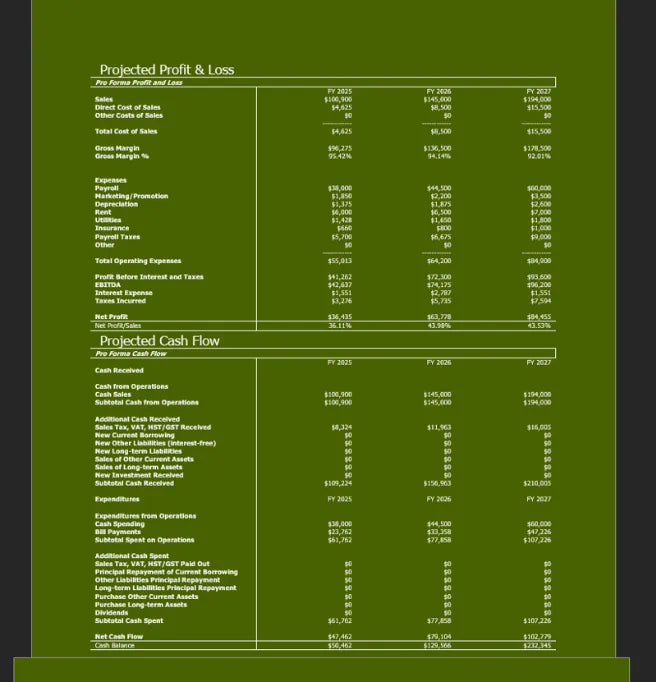
Mobile & Seasonal Business Plan Hub (U.S., 2025)
A single hub that ties together hot dog carts, shaved ice, cotton candy, hunting & fishing sh...
Read More →





Launch your axe throwing venue with a fully editable axe throwing business plan template that already follows the SBA-compliant format lenders expect. This business plan template is built for U.S. SBA loans, bank funding, and investor presentations without $700+ consultant fees, and it connects lane utilization, pricing, staffing, deposits, and safety SOPs into one lender-friendly document so banks, landlords, and insurers can verify your assumptions fast.
Instead of starting from a blank page, you get a complete axe throwing business plan with lender-ready wording, lane-utilization math, and a built-in three-year forecast. The narrative walks reviewers through deposits, no-show policies, safety procedures, insurance, and staffing ratios in a logical, bank-style order. Just plug in your local lease, lane count, pricing, and payroll to produce a polished plan for SBA loans, investors, or landlords in hours instead of weeks.
This axe throwing business plan template shows how leagues, private parties, and corporate events fill weekdays, protect peak blocks with deposits, and reach break-even lanes per hour without burnout-level staffing. You keep full control of the numbers and language while following a structure banks and underwriters already know.
Axe throwing venues sit at the intersection of entertainment, hospitality, and corporate team-building. Many operators combine lane-based sessions with leagues, private parties, and corporate events, and some add food, beer, or a full bar. Because of the physical risk, lenders and insurers expect a higher level of planning than a typical bar or arcade—clear safety procedures, coach-to-lane ratios, and documented training.
This template helps you document how many lanes you will open with, how you’ll price sessions, what your booking and deposit policies look like, and how you’ll satisfy local licensing, zoning, and insurance requirements. It gives underwriters a confident view of your axe throwing business model instead of a vague “fun place with axes” pitch.
An axe throwing business plan template is a pre-built, lender-ready document that outlines your venue concept, target customers, operations, safety procedures, and financial projections. Instead of writing each section from scratch, you start with a professionally written structure for an axe throwing range or entertainment venue and personalize it with your location, pricing, staffing, and branding.

The axe throwing business plan template ties price per thrower and session length to a clear capacity model: lanes × throwers per lane × sessions per hour. You’ll present deposits for peak slots, a simple cancellation window, and add-ons like leagues, coaching upgrades, and private events. Reviewers see a utilization chart by daypart, break-even lanes per hour, and a basic sensitivity run (−10% demand, +10% payroll) so repayment still looks realistic.
Because the forecast is editable, you can adjust lane count, opening hours, group size, insurance, and customer acquisition costs. Outputs map to standard SBA schedules (profit and loss, cash flow, startup budget) so underwriters can audit your inputs quickly.
Axe throwing venues are judged heavily on risk management. This template helps you document supervised lanes with barriers or cages, pre-session coaching, signed waivers, footwear and alcohol policies, and incident logging. You’ll spell out training cadence for coaches, your chosen insurance coverages, and limits. Tying these controls to your staffing plan shows that premiums and payroll line up with utilization and revenue, which is exactly what underwriters need to see.
Use the template toggles to run both scenarios and present the chosen path with a clear, lender-ready rationale.
Many venues open with 6–10 lanes. The forecast shows when utilization supports adding lanes or a second coach on peak blocks.
One-to-two is standard; move to one-to-one for beginner-heavy groups and reflect that in your staffing plan and safety notes.
Yes—collect deposits for peak hours and parties and use a 24–48 hour change/cancel window. The template shows how deposits protect margins and staffing.
Plan baseline at roughly 65–75% on core blocks. Protect peak blocks with deposits and shorter cancel windows; use leagues and weekday corporate groups to raise effective utilization.
Costs vary by lane count, build-out, and local codes. Plug build-out, cages/backstops, coaching headcount, insurance, and deposits into the model to see capex, opening working capital, and payback time.
Yes. Once purchased, you can duplicate the file and adjust assumptions for additional locations or expansion plans—no subscriptions or recurring fees.
Give lenders, landlords, and insurers a plan they can skim and verify in minutes while you keep full control of your venue’s concept and branding.
Buy Now & Download InstantlyLast updated: November 2025 by BPlanMaker. One-time purchase, no subscriptions or recurring fees.
BPlanMaker


Couldn't load pickup availability





Explore our latest articles on writing a stronger business plan, using your business plan template, and getting ready for lenders, investors, and SBA programs.

A single hub that ties together hot dog carts, shaved ice, cotton candy, hunting & fishing sh...
Read More →
U.S. 2025 guide to planning a shaved ice / snow cone business with the SBA-style layout lenders e...
Read More →
U.S. 2025 guide to planning a hunting & fishing shop with the SBA-style layout lenders expect...
Read More →